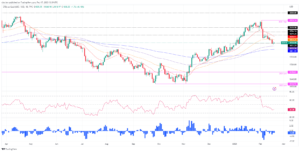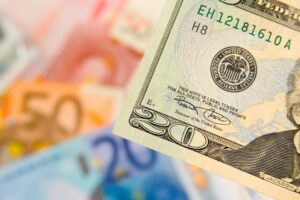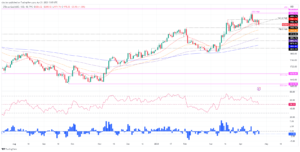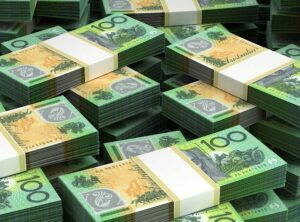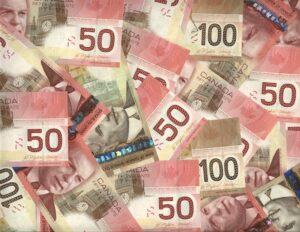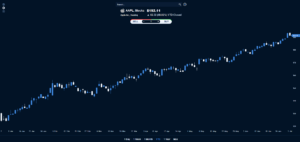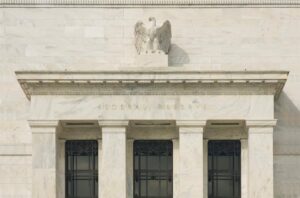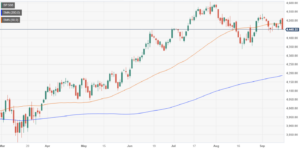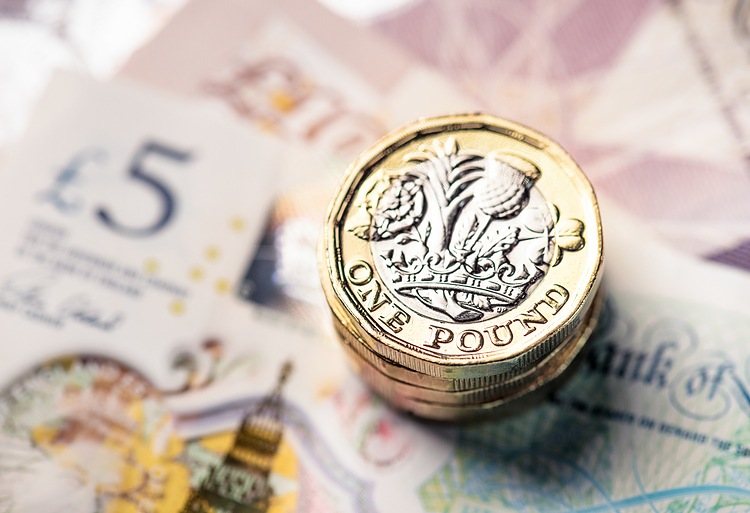
- Pound Sterling recovers swiftly as investors’ risk-appetite revives.
- Deepening UK recession fears could dent the Pound Sterling’s outlook.
- Persistent Fed rate-cut bets may continue to weigh on the US Dollar.
The Pound Sterling (GBP) is set to end 2023 with decent gains of almost 5.60%. The rally in the Pound Sterling is backed by consistently surging risk-appetite of the market participants due to easing fears of a global recession. Western central banks will likely wind-up their historically faster rate-tightening campaign amid easing price pressures, which has improved appeal for risk-sensitive assets.
The performance of the Pound Sterling against the US Dollar has remained better as the Bank of England (BoE) may be laggard in reducing borrowing rates among central banks from Group of Seven economies. Economic conditions for BoE policymakers are worsening again as the United Kingdom economy has been exposed to a technical recession due to a vulnerable demand environment. The BoE could begin cutting interest rates earlier to avoid fears of any economic shrinkage, which may dampen the Pound Sterling outlook significantly.
Daily Digest Market Movers: Pound Sterling rebounds while US Dollar recovery stalls
- Pound Sterling rebounds strongly after a gradual correction as the overall market mood is quite upbeat amid expectations that there won’t be any global recession as price pressures have eased significantly
- The appeal for risk-perceived assets is bullish as investors lean towards expectations of early rate cuts by the Federal Reserve.
- The Fed is expected to start lowering borrowing costs from March as price pressures in the United States economy are clearly in a downtrend.
- Action in the FX domain is expected to remain muted in the last trading session of 2023 but next week firecrackers are likely amid the release of the S&P Global PMI for the manufacturing and service sector.
- The Pound Sterling recovers as investors expect interest rate cuts from the Bank of England (BoE) to be delayed compared to the Fed and other central banks from the Group of Seven economies.
- The United Kingdom’s high inflation rate is the reason for expecting rate cuts to come later there than the other G7 nations.
- UK’s core inflation is slightly above 5% and policymakers lack confidence in achieving price stability in a timely manner due to robust wage growth.
- Market participants are already pricing in a decline in Fed-BoE policy divergence, which is likely from March 2024.
- Higher demand for the Pound Sterling against the US Dollar could fade as conditions of a technical recession in the UK economy are strengthening, which could force the BoE to announce rate cuts earlier-than-anticipated.
- Revised estimates from the UK Office for National Statistics (ONS) have indicated that the economy contracted by 0.1% in the third quarter of 2023.
- The BoE is not expecting growth in the final quarter of 2023, which indicates a technical recession is highly likely.
- A recession situation may force the BoE to start unwinding its restrictive monetary policy stance.
- Meanwhile, the recovery in the US Dollar Index (DXY) has stalled amid persistent Fed’s rate cut bets. The USD Index is facing pressure near 101.30 and is expected to fall back towards five-month low near 100.60.
- The USD Index has been facing an intense sell-off as a higher for longer interest-rate stance from Fed policymakers has given way to expectations of rate cuts, as the central bank tries to avoid the consequences of over-tightening.
- Next week, investors will focus on the ISM Manufacturing PMI and the Employment data for December, which will provide guidance for further action by the Fed in its first monetary policy meeting of 2024 on January 31.
Technical Analysis: Pound Sterling recovers from 1.2700
Pound Sterling rebounds after correcting on Thursday as the risk-appetite of the market participants has surged again. The GBP/USD pair is aiming to recapture its five-month high of 1.2870. A rally in the Cable may continue as the 20 and 50-day Exponential Moving Averages (EMAs) are advancing. Momentum oscillators indicate sheer strength in the upside move.
Pound Sterling FAQs
The Pound Sterling (GBP) is the oldest currency in the world (886 AD) and the official currency of the United Kingdom. It is the fourth most traded unit for foreign exchange (FX) in the world, accounting for 12% of all transactions, averaging $630 billion a day, according to 2022 data.
Its key trading pairs are GBP/USD, aka ‘Cable’, which accounts for 11% of FX, GBP/JPY, or the ‘Dragon’ as it is known by traders (3%), and EUR/GBP (2%). The Pound Sterling is issued by the Bank of England (BoE).
The single most important factor influencing the value of the Pound Sterling is monetary policy decided by the Bank of England. The BoE bases its decisions on whether it has achieved its primary goal of “price stability” – a steady inflation rate of around 2%. Its primary tool for achieving this is the adjustment of interest rates.
When inflation is too high, the BoE will try to rein it in by raising interest rates, making it more expensive for people and businesses to access credit. This is generally positive for GBP, as higher interest rates make the UK a more attractive place for global investors to park their money.
When inflation falls too low it is a sign economic growth is slowing. In this scenario, the BoE will consider lowering interest rates to cheapen credit so businesses will borrow more to invest in growth-generating projects.
Data releases gauge the health of the economy and can impact the value of the Pound Sterling. Indicators such as GDP, Manufacturing and Services PMIs, and employment can all influence the direction of the GBP.
A strong economy is good for Sterling. Not only does it attract more foreign investment but it may encourage the BoE to put up interest rates, which will directly strengthen GBP. Otherwise, if economic data is weak, the Pound Sterling is likely to fall.
Another significant data release for the Pound Sterling is the Trade Balance. This indicator measures the difference between what a country earns from its exports and what it spends on imports over a given period.
If a country produces highly sought-after exports, its currency will benefit purely from the extra demand created from foreign buyers seeking to purchase these goods. Therefore, a positive net Trade Balance strengthens a currency and vice versa for a negative balance.
- SEO Powered Content & PR Distribution. Get Amplified Today.
- PlatoData.Network Vertical Generative Ai. Empower Yourself. Access Here.
- PlatoAiStream. Web3 Intelligence. Knowledge Amplified. Access Here.
- PlatoESG. Carbon, CleanTech, Energy, Environment, Solar, Waste Management. Access Here.
- PlatoHealth. Biotech and Clinical Trials Intelligence. Access Here.
- Source: https://www.fxstreet.com/news/pound-sterling-capitalizes-on-risk-on-mood-investors-ignore-uk-recession-fears-202312290743
- :has
- :is
- :not
- ][p
- $UP
- 1
- 100
- 2%
- 20
- 2022
- 2023
- 2024
- 30
- 31
- 32
- 35%
- 60
- a
- above
- access
- According
- Accounting
- Accounts
- achieved
- achieving
- Action
- Ad
- Adjustment
- advancing
- After
- again
- against
- Aiming
- aka
- All
- All Transactions
- almost
- already
- Amid
- among
- an
- analysis
- and
- Animate
- Announce
- any
- appeal
- ARE
- around
- AS
- Assets
- attract
- attractive
- averaging
- avoid
- back
- backed
- Balance
- Bank
- Bank of England
- Bank of England (BOE)
- Banks
- BE
- been
- begin
- benefit
- Bets
- Better
- between
- Billion
- BoE
- borrow
- Borrowing
- Bullish
- businesses
- but
- buyers
- by
- cable
- Campaign
- CAN
- central
- Central Bank
- Central Banks
- clearly
- come
- compared
- conditions
- confidence
- Consequences
- Consider
- consistently
- content
- continue
- Core
- core inflation
- Costs
- could
- country
- created
- credit
- Currency
- Cut
- cuts
- cutting
- data
- day
- December
- decent
- decided
- decisions
- Decline
- Delayed
- Demand
- difference
- Digest
- direction
- directly
- Divergence
- does
- Dollar
- dollar index
- domain
- due
- Dxy
- Earlier
- Early
- easing
- Economic
- Economic Conditions
- Economic growth
- economies
- economy
- employment
- encourage
- end
- ends
- England
- Environment
- estimates
- exchange
- expanded
- expect
- expectations
- expected
- expecting
- expensive
- exponential
- exports
- exposed
- extra
- facing
- factor
- fade
- Fall
- Falls
- FAQ
- faster
- fears
- Fed
- Federal
- federal reserve
- final
- First
- Focus
- For
- Force
- foreign
- foreign exchange
- foreign investment
- Fourth
- from
- further
- FX
- G7
- Gains
- gauge
- GBP
- GBP/USD
- GDP
- generally
- given
- Global
- global recession
- goal
- good
- goods
- gradual
- Group
- Growth
- guidance
- Have
- Health
- High
- High inflation
- higher
- highly
- historically
- HTTPS
- if
- Impact
- important
- imports
- improved
- in
- index
- indicate
- indicated
- indicates
- Indicator
- Indicators
- inflation
- inflation rate
- influence
- influencing
- interest
- INTEREST RATE
- Interest Rates
- Invest
- investment
- Investors
- Issued
- IT
- ITS
- January
- jpg
- Key
- Kingdom
- known
- Lack
- Last
- later
- likely
- longer
- Low
- lowering
- make
- Making
- manner
- manufacturing
- March
- March 2024
- Market
- May..
- measures
- meeting
- module
- Momentum
- Monetary
- Monetary Policy
- money
- mood
- more
- most
- move
- Movers
- moving
- moving averages
- National
- Nations
- Near
- negative
- net
- next
- next week
- of
- Office
- official
- oldest
- on
- only
- or
- Other
- otherwise
- Outlook
- over
- overall
- pair
- pairs
- Park
- participants
- People
- performance
- period
- Place
- plato
- Plato Data Intelligence
- PlatoData
- pmi
- policy
- policymakers
- positive
- pound
- pound sterling
- pressure
- price
- pricing
- primary
- produces
- projects
- provide
- purchase
- purely
- put
- Quarter
- quite
- raising
- rally
- Rate
- Rates
- reason
- recession
- record
- Recovers
- recovery
- reducing
- release
- Releases
- remain
- remained
- Reserve
- Restrictive
- robust
- S&P
- S&P Global
- scenario
- sector
- seeking
- sell-off
- service
- Services
- session
- set
- Sets
- seven
- sign
- significant
- significantly
- single
- situation
- Slowing
- So
- Stability
- stance
- start
- starts
- States
- statistics
- steady
- sterling
- strength
- Strengthen
- strengthening
- Strengthens
- strong
- strongly
- such
- Surged
- surging
- swiftly
- Technical
- than
- that
- The
- the Fed
- The Group of Seven
- the UK
- the United Kingdom
- the world
- their
- There.
- therefore
- These
- Third
- this
- thursday
- timely
- to
- too
- tool
- towards
- trade
- traded
- Traders
- Trading
- trading pairs
- Transactions
- try
- Uk
- uk recession
- unit
- United
- United Kingdom
- United States
- upbeat
- Upside
- us
- US Dollar
- US Dollar Index
- USD
- value
- vice
- Vulnerable
- wage
- Way..
- week
- weigh
- Western
- What
- whether
- which
- while
- will
- with
- world
- zephyrnet

